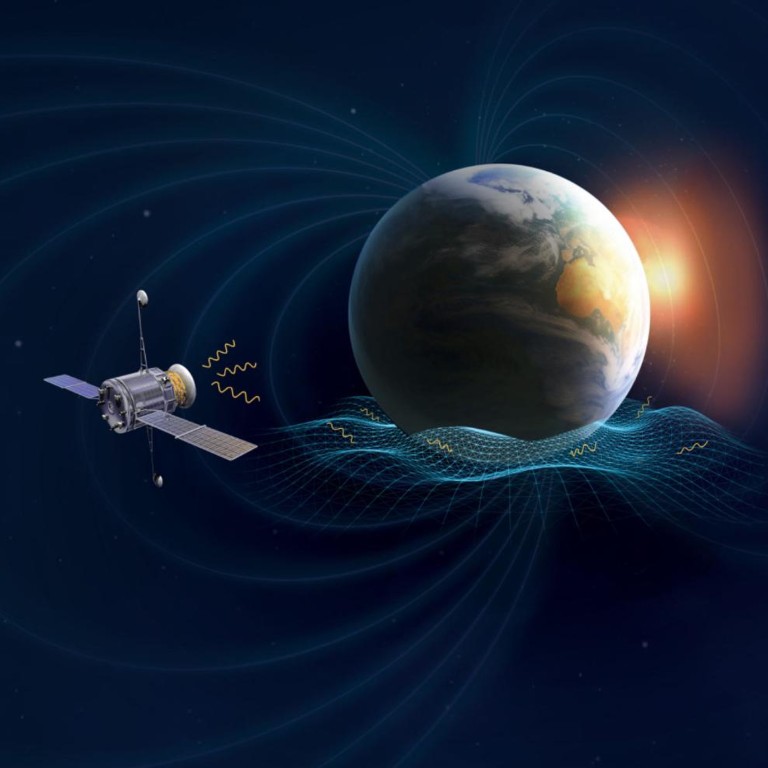
Could planets like Earth and Jupiter be used as ‘laboratories’ to help unlock cosmic mysteries?
- Their magnetospheres may be a way to detect elusive gravitational waves, according to team in Beijing and Hong Kong
- But they say their study should be seen as ‘a starting point for more systematic exploration of the opportunities’
Scientists say planets in our solar system, such as Earth and Jupiter, could be used to detect gravitational waves and better understand cosmic mysteries – from the very early universe to dark matter.
The researchers from the Institute of High Energy Physics in Beijing and the Hong Kong University of Science and Technology said the magnetospheres of these planets would act like a gigantic observatory.
That is because they would help convert elusive gravitational waves into light particles which could be picked up by specially designed probes in orbit, the team wrote in the peer-reviewed journal Physics Review Letters last month.
Gravitational waves for dummies: what are they and why are scientists so excited about them?
They said this innovative approach might lead to the observation of high-frequency gravitational waves, which were potentially produced right after the Big Bang and are impossible to detect with existing ground-based facilities.
“We demonstrate that the nearby planets, such as Earth and Jupiter, can be utilised as a laboratory for detecting the high-frequency gravitational waves,” the researchers wrote.
Gravitational waves are ripples of space-time caused by the most violent processes in the universe. For instance, the collision of two orbiting black holes can release a huge amount of gravitational energy, which propagates in all directions away from the source.
Travelling at the speed of light, these cosmic ripples carry basic information about their origins and the nature of gravity itself.
While Albert Einstein predicted the existence of gravitational waves, their detection has been notoriously difficult because the waves do not interact much with most matter. Also, they are often weak and only disturb space-time by a barely measurable amount.
LIGO’s success motivated a series of ongoing and planned projects to hunt for gravitational wave signals below 10,000 hertz, study co-author Ren Jing from the Institute of High Energy Physics told Science and Technology Daily on Sunday.
But she said detecting high-frequency gravitational waves was of great scientific value since they were likely generated in the little-known early universe. That includes the merger of primordial black holes, which created the world’s first gravitational waves and contain key information about dark matter.
Scientists have explored ways to observe high-frequency gravitational waves indirectly, including one based on the so-called inverse Gertsenshtein effect. That describes the conversion between gravitational waves and electromagnetic waves in the presence of an external magnetic field.
When light passes through a strong magnetic field, it will produce a gravitational wave – and vice versa, according to Russian physicist Mikhail Gertsenshtein.
For a long time, this idea was considered experimentally impractical because the magnetic field needs to be astronomically large and distributed very broadly in space.
Chinese team finds key evidence for low-frequency gravitational waves
In their study, the Chinese team proposed to use Earth and Jupiter as an enormous magnet for the inverse Gertsenshtein effect to happen.
The Earth’s magnetic field originates from the motion of molten iron at its core, which forms a magnetosphere stretching far into space and sheltering the planet from solar flares and cosmic radiation.
The researchers calculated the potential amount and frequencies of light particles to be produced with high-frequency gravitational waves passing through the magnetospheres of Earth and Jupiter. They said the results were very encouraging.
The team also used existing scientific probes – including Japan’s low-Earth-orbit, X-ray astronomy satellite Suzaku and Nasa’s Juno spacecraft currently orbiting Jupiter – to show that they might have already caught some of the light particles converted from gravitational waves.
“Compared with other detection methods, our approach can cover a broad range of gravitational wave frequencies. We will also be confident about the magnetic field strength, among other advantages,” co-author Liu Tao from the Hong Kong University of Science and Technology told the newspaper.
The researchers said the orbit and direction of the probe should be carefully designed to optimise the detection results.
“[Our study] should be considered as a starting point for more systematic exploration of the opportunities presented by such a natural laboratory,” they wrote.

